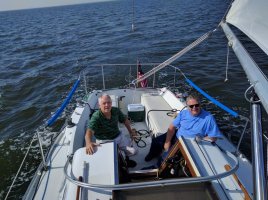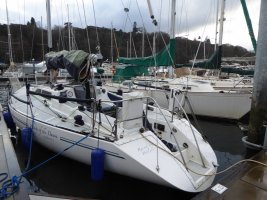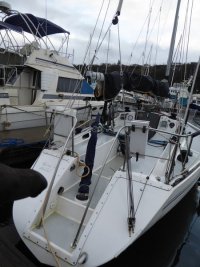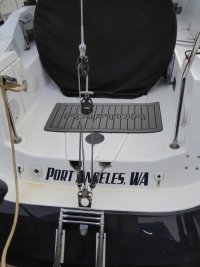Hi all,
Looking for some wisdom/advice.
I currently have a split back stay with the associated tensioning device. Works fine as far as tensioning goes. I am not entirely happy with it though.
I think that when it was installed the brackets that the split attaches to were installed under zero tension. As a result, when tension is applied, an angle develops between the bolt line on the bracket and the rigging wire. More tension, bigger angle. I recognize that some variation in the angle is inevitable, but I seem to be on the wrong side of things. Would prefer if it had been installed so that things lined up when tension was high.
In addition, the split back stay simply gets in the way all the time. I am on the tall end of the spectrum so when standing it gets in the way. It also seems to magically get in the way when I am sitting.
So, thinking to go back to a single back stay. Options are a hydraulic tensioner (big $), a "screw/wheel" style tensioner (less $ but bulky), or a simple block/tackle system.
I am leaning towards the simple block/tackle system. My question is - how does one size the block tackle system? What is the backstay load on an E29?
Thanks in advance,
Peter
Looking for some wisdom/advice.
I currently have a split back stay with the associated tensioning device. Works fine as far as tensioning goes. I am not entirely happy with it though.
I think that when it was installed the brackets that the split attaches to were installed under zero tension. As a result, when tension is applied, an angle develops between the bolt line on the bracket and the rigging wire. More tension, bigger angle. I recognize that some variation in the angle is inevitable, but I seem to be on the wrong side of things. Would prefer if it had been installed so that things lined up when tension was high.
In addition, the split back stay simply gets in the way all the time. I am on the tall end of the spectrum so when standing it gets in the way. It also seems to magically get in the way when I am sitting.
So, thinking to go back to a single back stay. Options are a hydraulic tensioner (big $), a "screw/wheel" style tensioner (less $ but bulky), or a simple block/tackle system.
I am leaning towards the simple block/tackle system. My question is - how does one size the block tackle system? What is the backstay load on an E29?
Thanks in advance,
Peter




